Spine
Neck
Neck-Stretching Exercises for Torticollis
Neck-stretching exercises have been recommended for your child because he or she has tightness in his or her neck muscles that is limiting neck movement. These exercises should be performed with each diaper change, or at least 5 times a day, until your child's neck has a normal range of motion.
Exercise 1: The first exercise is designed to improve rotation of your child's head to the right and left. Place one hand on your child's chest. Place the other hand on the side of your child's face. Gently but firmly turn the head so that the chin moves toward the shoulder. Turn the head only to the point of resistance, hold for 10 seconds, and release. Switch hands and repeat the same steps, turning the head to the shoulder in opposite direction.
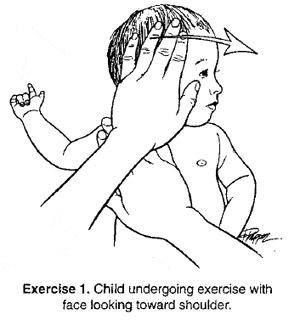
Exercise 2 : The second exercise is designed to improve bending of your child's head to the side. Place one hand on your child's upper chest and shoulder area so that his or her body does not move. Hold the top of your child's head with the other hand. Gently but firmly tilt the head to the side, pressing the ear toward the shoulder. Press only to the point of resistance, hold 10 seconds, and release. Switch hands and repeat the same steps, tilting the opposite ear to the shoulder.
During the exercises that move the tight area of your child's neck, your child will fuss and squirm. However, consistent use of these exercises gradually will improve your child's neck mobility.
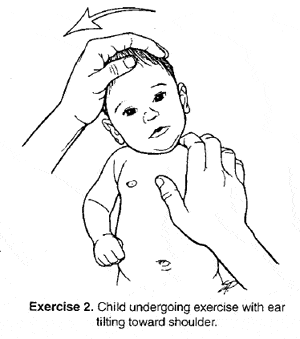
Instructions for Stretching and Positioning Sternomastoid Torticollis
LEFT TILT = tilts left, prefers to look right
RIGHT TILT= tilts right, prefers to look left
Stretching
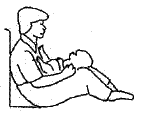
- For the following stretching exercises, the parent sits with the back against the wall and knees bent
- Place the child in your lap, with the child on her back and knees tucked
- Or place baby on flat surface (bed, couch, floor) while you kneel above
LEFT TILT
Sidebending
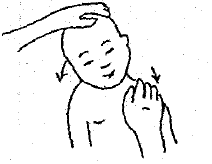
- Hold the child's LEFT shoulder down with your RIGHT hand
- Place your LEFT hand on top of the LEFT side of the child's head, and slowly bend her head towards her RIGHT shoulder
- Hold the position for 10 seconds. Repeat 15 times, 4 to 6 times a day
Rotation
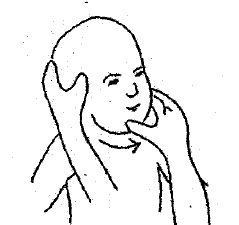
- Place your LEFT forearm against the child's RIGHT shoulder, and cup the child's head with the same hand
- Use your RIGHT hand to hold the child's chin
- Slowly rotate the child's face to her LEFT
- Hold the position for 10 seconds. Repeat 15 times, 4 to 6 times a day
Positioning
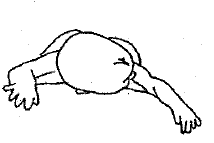
When the child is on her stomach, position all toys so that the child has to turn her face to the LEFT.
Carrying
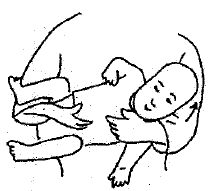
- Hold the child facing away from you, in a side-lying position, with the child's LEFT ear resting against your LEFT forearm
- Place your RIGHT arm between the child's legs and support the child's body
- Carry the child in this position as much as possible
Other Suggestions
- Hold toys so that the child has to look up and out to her LEFT
- Position child in crib so that activities in the room encourage her to look LEFT
- While bottle feeding the child, position her to face LEFT
RIGHT TILT
Sidebending
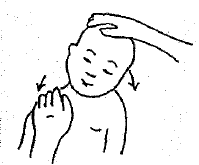
- Hold the child's RIGHT shoulder down with your LEFT hand
- Place your RIGHT hand on top of the RIGHT side of the child's head, and slowly bend her head towards her LEFT shoulder
- Hold the position for 10 seconds. Repeat 15 times, 4 to 6 times a day
Rotation
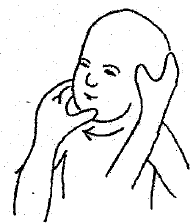
- Place your RIGHT forearm against the child's LEFT shoulder, and cup the child's head with the same hand
- Use your LEFT hand to hold the child's chin
- Slowly rotate the child's face to her RIGHT
- Hold the position for 10 seconds. Repeat 15 times, 4 to 6 times a day
Positioning
When the child is on her stomach, position all toys so that the child has to turn her face to the RIGHT.
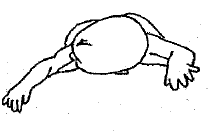
Carrying
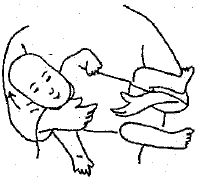
- Hold the child facing away from you, in a side-lying position, with the child's RIGHT ear resting against your RIGHT forearm
- Place your LEFT arm between the child's legs and support the child's body
- Carry the child in this position as much as possible
Other Suggestions
- Hold toys so that the child has to look up and out to her RIGHT
- Position child in crib so that activities in the room encourage her to look RIGHT
- While bottle feeding the child, position her to face RIGHT
- While holding the baby across the shoulder, position her to face RIGHT
How To Make Tummy Time And Stretching More Enjoyable For All
- Blow bubbles in the direction you would like baby to look. Also good for strengthening because they tend to reach with the weak hand
- Tickle, laugh, sing songs, make funny faces
- Have someone help distract baby. Older siblings work well as do pets
- Use a mirror to capture baby's attention
- Kisses on the cheek to make the head turn
- Blow in baby's ear to make the head turn
Alternative Stretches
- If you can't do the stretches work on strengthening the weak side.
- Do the rotation stretch with baby sitting in you lap. Back to your chest. Do this in front of a mirror. Hold one arm across baby's chest for support. Use free hand to gently turn head desired direction.
- Do the carrying hold on the floor. Place baby's head against the floor instead of your arm. Support the body up away from the floor. The floor will do the stretch. Make this a game.
- Do stretches while baby is asleep. This is excellent. Try it a couple of times before completely ruling out. Wait until baby has been asleep 10-15 minutes.
- Remember that babies are much more flexible than adults. Their range of motion can be 110% (i.e. turn head slightly further than shoulder and touch ear to shoulder). It is highly unlikely you will over stretch your baby. If you feel uncomfortable check with your PT or Dr.
Crawlers
Crawling is a great muscle builder! Encourage your crawler to crawl. Buying the tubes, tumblers, and tunnel toys are great play toys that encourage crawling, and therefore strengthen those wimpy shoulders (not developed well due to tummy time aversion!). Get on the floor and "chase" your baby.
Fighting the Stretches
There is a difference between not liking the stretches and fighting them to the point of doing harm (i.e. strengthening the already strong muscle). A trained PT is really the only one who can truly tell the difference. However, around age 12 months (some earlier and some later) most babies are really fighting. If your baby really fights then talk to your PT about alternatives. Ask your PT if you should continue the stretches. Do not stop stretches without speaking to your PT. You will need to do extra strengthening moves to compensate. Not doing anything will do even more harm.
Additional Strengthening Moves
- Position baby so they have to look the hard way to see the fun stuff, i.e. TV, toys, other people, siblings, pets, etc.
- Do you own PT sessions 1-3 times each day. Get down on the floor with your baby and make them look and turn in the "right" direction. Tort babies like to cheat and turn their whole body. Make sure they are only using their necks (most of the time). If they start to turn the whole body, stop, get their attention straight ahead again and then move their attention to the correct side.
- Try to get older babies to reach with the hand opposite the tilt (on the weak side). • Put finger foods closer to the weak side so baby uses the weak side.
- Do the exercise ball strengthening moves while baby sits on your legs or lap. You can move baby side to side and front to back without the ball. Baby will naturally want to "right" his/her head. Tilt baby towards the tilt, i.e. left tilt move towards baby's left that will force baby to pull head towards right.
- Try head righting exercises in front of a mirror. Hold baby at waist and tip the body so baby has to work against gravity to right his/her head. This forces baby to hold his own head up. The goal is to go past midline.
- Blow bubbles to baby's weak side encouraging him to reach with weak arm and look in "right" direction.
- Do the "wheelbarrow". Basically you get on your knees and hold the baby's legs and support their
abdomen/chest with one hand with their hands on the ground. Push forward slightly to get them to "crawl" forward with their arms. You can move the support hand closer to you as they gain more strength.
Cervical Strain and Sprain
Description
Cervical strain/sprain is an injury to the neck caused when it is forcefully whipped or forced backward or forward. The structures involved are the muscles, ligaments, tendons, discs, and nerves in the neck.
Common Signs and Symptoms
- Pain or stiffness in the front and back of neck, either immediately following or up to 24 hours after the injury
- Dizziness, headache, and nausea and vomiting
- Muscle spasm with soreness and stiffness in the neck
- Tenderness and swelling at the injury site
Causes
Injury, usually from contact sports or motor vehicle accident
Risk Increases With
- Osteoarthritis of the spine
- Situations that make accidents more likely or direct trauma, including tackling with the head (spearing), head-butting, and landing on the top of the head
- High-risk sports, including football, rugby, wrestling, hockey, auto racing, gymnastics, diving, contact karate, and boxing
- Poor neck conditioning (flexibility and strength)
- Previous neck injury
- Poor tackling technique
- Ill-fitting equipment
Scoliosis
Pediatric Orthopedic Specialists of Orange County is one of Southern California's premier orthopaedic medical groups located in the City of Orange. APOS offers a broad line of professional orthopedic services; including Spine Surgery, Total Joint Replacement, Sports Medicine, Foot and Ankle, Hand and Upper Extremity, and General Orthopedics. In addition to the Physicians clinic, the center offers physical and aquatic therapy as well as MRI.
What Is Scoliosis?
Everyone's spine has natural curves. These curves round our shoulders and make our lower back curve slightly inward. But some people have spines that also curve from side to side. Unlike poor posture, these curves can't be corrected simply by learning to stand up straight.
This condition of side-to-side spinal curves is called scoliosis. On an x-ray, the spine of a person with scoliosis looks more like an "S" or a "C" than a straight line. Some of the bones in a scoliotic spine also may have rotated slightly, making the person's waist or shoulders appear uneven.
Scoliosis is a descriptive term and not a diagnosis. In more than 80% of the cases, a specific cause is not found and such cases are termed idiopathic meaning "of undetermined cause." This is particularly true among the type of scoliosis seen in adolescent girls. Conditions known to cause spinal deformity are congenital spinal column abnormalities, neurological disorders, genetic conditions and a multitude of other causes. Scoliosis does not come from carrying heavy things, athletic involvement, sleeping/standing postures, or minor lower limb length inequality.
Do I Have Scoliosis?
Determining whether or not you have scoliosis is best done by a physician who performs a physical examination of your back. The examination is done with you standing in a relaxed position with your arms at your sides. The physician will view you from behind looking for curvature of the spine, shoulder blade asymmetry, waistline asymmetry and any trunk shift. You will then bend forward at the waist and the physician will view your back once again to look for the rotational aspect of the scoliosis in the upper part of the back (rib prominence) or in the lower part of your back (flank or waist prominence). Following this simple examination, the physician will usually initial radiographs of the spine viewed from the back and the side to see the entire spine from the neck to the pelvis. If scoliosis is present, the physician will measure the radiographs and provide you with a numberical value, in degrees, to help describe the scoliosis.
What Are My Treatment Options?
The treatment options for scoliosis fall into three main categories: observation of the scoliosis, nonoperative treatment and surgical treatment.
- Observation: This is for curves that have a small degree measurement when you are growing (adolescent scoliosis), or for moderate size curves (< 40-45 degrees) when you are done growing. For adults, observation and physical therapy are for those patients who have mild symptoms and have curves which are not large.
- Bracing: This is for curves between 25 and 45 degrees in growing children to prevent further progression of the curve while growth of the spine remains. The goal of bracing is to prevent further progression since the brace cannot correct curves.
- Surgical treatment: This reserved for curves which are generally greater than 50 degrees for adolescent patients and adults. Surgery can be performed for smaller curves if the appearance of the curvature is bothersome to the patient or if symptoms are associated with the scoliosis in the adult patient. The goals of surgical treatment are to obtain curve correction and to prevent curve progression. This is generally achieved by placing metal implants onto the spine which are then attached to rods which correct the spine curvature and hold it in the corrected position until fusion, or knitting of the spine elements together.
You will need the Adobe Reader to view and print the above documents. 
